One of the cornerstones of classic menswear is a pair of pleated pants (or trousers, if you’re across the pond). Whether they’re worn as part of a suit or as a separate piece of clothing, there’s no denying the mix of comfort and timeless elegance that one gets when wearing them. However, pleated pants are increasingly difficult to find these days, so we thought it was high time to get out our sartorial spyglass and look into why this is the case.
- What are Pleated Pants?
- History of Pleated Pants
- 6 Reasons Why Men Stopped Wearing Pleated Pants
- 1. Pleats Can Be Unflattering, If Cut Poorly
- 2. Some Fabrics Don’t Take A Pleat Well
- 3. Casualization of Menswear
- 4. “Nerd” Associations
- 5. Pleats are Associated with the Workplace
- 6. Modern-Day Clothing Trends
- Conclusion
- Outfit Rundown
What are Pleated Pants?
To begin today’s analysis, we first have to answer the broader question of just what pleated pants are. In simplest terms, pleats are gathered folds of cloth where the Z-shaped fold is pressed and sewn into a garment to control the volume of fabric, provide shape to the garment, and allow for a greater range of movement.
Pleats can be found on all different types of clothing, including jackets, overcoats, shirts, skirts, or kilts and, of course, pants. Some trouser pleats are sewn directly into the waistband and other trouser styles, like those with a Hollywood waist, forgo the separate waistband altogether.
Additionally, trouser pleats can be made to face inward as forward pleats or outward as reverse pleats. In addition to allowing for a greater range of movement in the leg of the trouser, they also shape the trouser leg and allow the fabric to drape more attractively.
And, of course, the alternative to pleated pants is the flat-fronted trouser, which is pretty self-explanatory. With that out of the way, in order to understand where pleats went, we have to know first where they came from.
History of Pleated Pants
You could, of course, be forgiven for thinking that traditional trousers have always borne some kind of pleat but, in fact, this isn’t the case. Indeed, throughout most of history, trousers were predominantly flat-fronted. Even the famously large Oxford bags of the 1920s and 30s were flat-fronted most of the time. And while pleats, as we know them today, did come about in the 1920s, there was also a fad for pleat-like styles a hundred years earlier in the 1820s.
The Regency Era, specifically from about 1811 to 1820 or so, saw the popularization of longer trouser legs as compared to the breeches that had come before them. These longer trousers were cut close to the body and were held up by suspenders or braces.
But, as these trouser styles began to widen around the leg, that opened the door to the fashion fad known as the “Cossack trouser,” which featured many pleats at the front of the trousers similar to a too-tight drawstring on a pair of pajama pants.
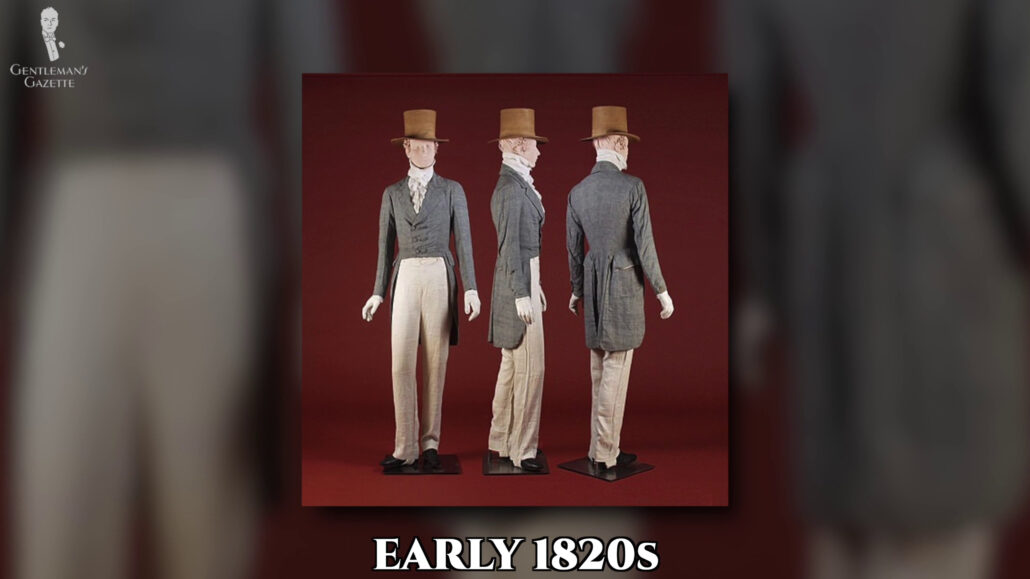
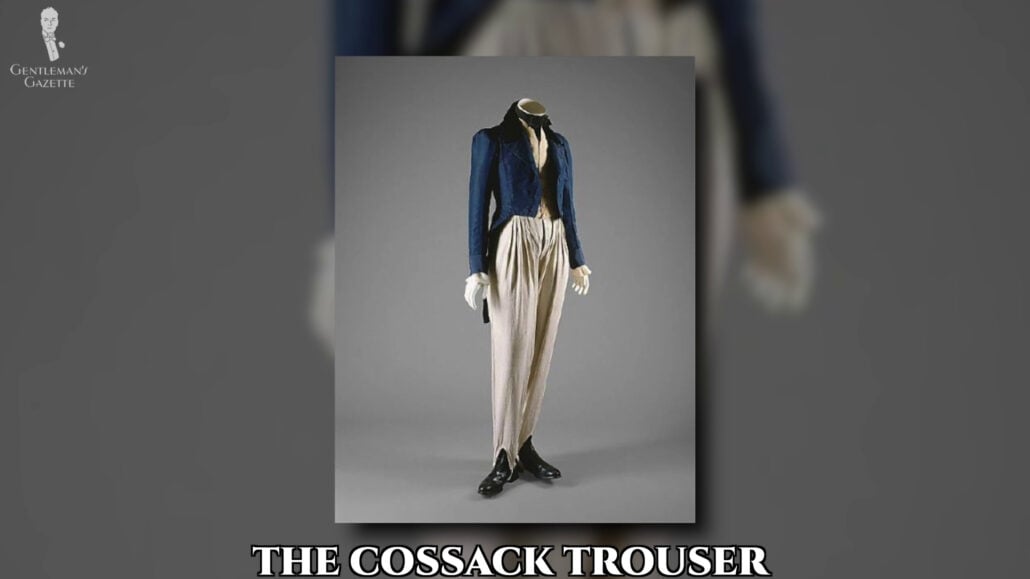
While these trousers didn’t fit as tightly as the previous breeches did, they were secured to the shoes with stirrups or straps. This meant that the trouser leg had to taper as it made its way down to the ankle, giving the ensemble a sort of chicken leg look that was frequently lampooned by cartoonists of the time.
After this fad died out, though, and as men continued to wear long trousers throughout the Victorian Era, they would experience bagging and stretching around the knee that looked unsightly.
To combat this, trouser stretching and creasing services were offered and, by the 1880s, men were stretching and creasing their trousers themselves with at-home devices. Irons could also accomplish this task and this method of pressing or creasing trousers has stuck around to this day.
An alternative form of trouser around this time was the “knickerbocker,” which were short trousers that stopped just below the knee. Coming into fashion around the 1860s, they were at first used mostly for sporting events and, while they were flat-fronted around the waist, they did feature darts at the bottom to keep a close fit around the knee.
By the 1920s, knickerbockers would evolve into “plus fours,” named so because of the length that they extended past the knee plus four inches or so, and the main difference in this evolution was the inclusion of darts or pleats at not only the knee, but also at the waist for added comfort and range of motion.
These were typically reserved purely for country or casual wear and the Prince of Wales, Edward VIII, ever the fashion plate, wore a pair on a trip to America in 1924.
Shortly after this, long trousers with pleats at the waistband started being produced and men enjoyed them not only for the comfort and range of motion, but also because they kept their creases intact better as well.
Moving into the 1930s and 40s, pleated trousers were really seen everywhere. As the structure of suit jackets widened at the shoulders and became fuller in the chest, pleats in the trouser waistband helped give volume to the legs as well without making the wearer look like they were wearing a pair of clown pants.
Indeed, the subtle and slim silhouette of the 1920s had evolved into a fuller, more angular hourglass shape by the 1930s, and it’s at this point that pleated pants made a home for themselves in the closet of almost every man the world over, both as part of a suit and more casually through the 40s, 50s, and 60s.
As is often the case with traditional clothing styles, though, the popularity of pleats waned around the end of the 60s and, by the 1970s, slimmer flat-fronted trousers were in style again. But, of course, the 1980s was greatly influenced by the Golden Age of menswear and so, pleats made a return in both casual wear and business and formal wear.
The 80s though represented the last period of true mainstream appeal for pleats, so it’s at this point in our historical overview that we finally get to our main question of the day: “Why did men stop wearing them?
6 Reasons Why Men Stopped Wearing Pleated Pants
We’ve found six compelling reasons why we believe the pleated trouser has lost its luster and for our first reason, we’ll zero in on the pleat itself as that’s sort of integral to this post.
1. Pleats Can Be Unflattering, If Cut Poorly
This first reason, then, is that pleats can be unflattering if they’re cut poorly. In other words, a pleat has to be cut and sewn well in order to be maximally functional and aesthetically pleasing.
On flat-fronted trousers, the center crease of each leg dissipates the closer it gets to the waistband. This can speed up the process of the crease flattening out as it works its way down the leg and, with no clear guide, it can be harder to re-press this crease each time.
Meanwhile, with a pleat at the top of your trousers, not only do you have a clearer guide for pressing this crease, but the extra fabric will also ensure that it stays in for a longer period of time. Of course, this works best when the pleat is properly cut and sewn into the trousers, but this does require a bit more fabric, as we can see in the roomier pleated pants of yesteryear.
As we know though, many modern-day manufacturers will do everything that they can to increase their profitability and, therefore, a pair of fabric-hungry pleated pants are going to cost the manufacturer and, therefore, the consumer, more on average than a flat-fronted pair. It’s also for this reason that many pairs of modern-day pleated trousers are going to look a bit lackluster, to say the least.
The issue here is that there simply isn’t enough fabric in the pleats and, therefore, they’re too shallow to make a difference when pressing and they also don’t contribute to a more refined appearance.
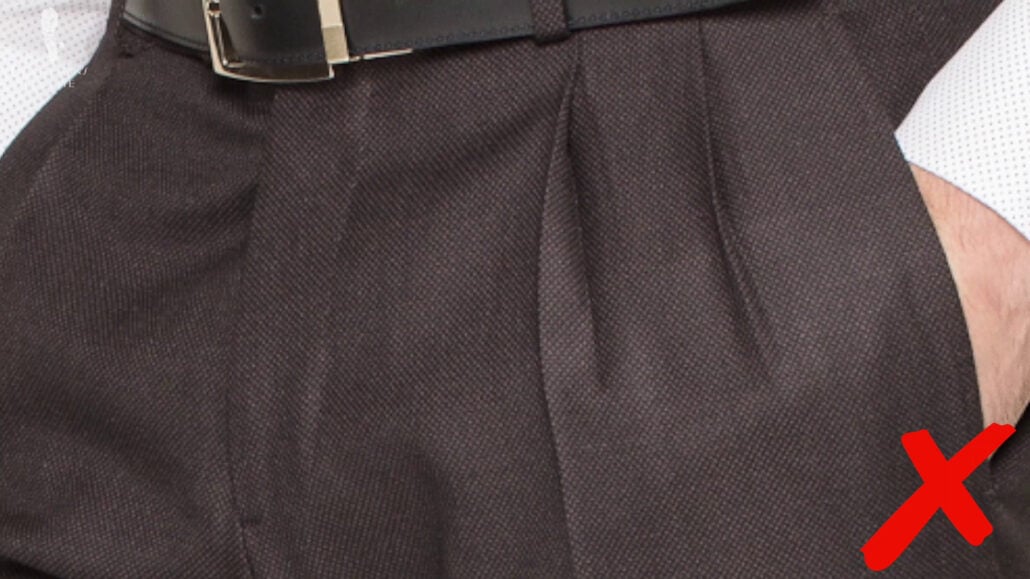
Can India Beat Savile Row for THE BEST Custom Pants?
2. Some Fabrics Don’t Take A Pleat Well
Following on from poorly constructed pleats, our second main reason today is that some fabrics simply don’t take a pleat very well.
Back in the heyday of pleated pants, clothing was typically made from sturdier stuff and, even though central heating was becoming increasingly more common, many men were still wearing garments made from fabric that was heavier than what we’d experienced today.
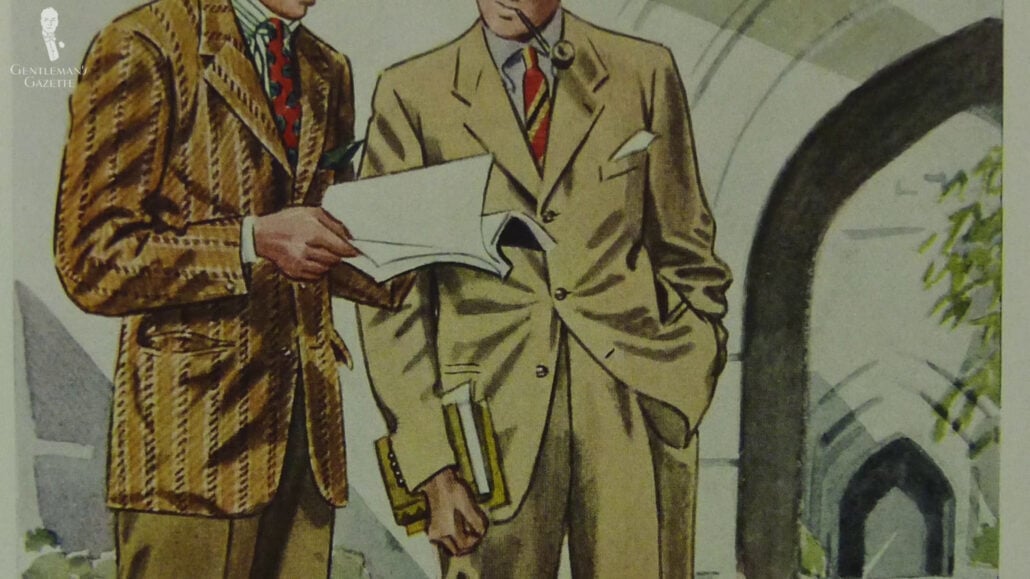
Suits were almost always made from some variety of wool and this could be two to three times weightier on average than the wool used to construct modern suits. Cloth with this much substance to it hung and draped from the body beautifully, leading to cleaner lines and far fewer wrinkles.
Nowadays, though, clothing can be made from pretty much anything and the biggest difference, especially when it comes to suits, is the weight of the cloth or, perhaps we should say, the lack thereof. Superfine wools and wool-blend cloth simply don’t have the substance to hold a good trouser pleat well and, as for trousers made from man-made fabrics like polyester and nylon, we’ll let this picture do the talking.
The result of using these lackluster fabrics to make pleated trousers, then, is that the pleats are constantly going to billow or balloon open in an unsightly fashion, which is likely why more men these days are simply opting for flat-fronted trousers.
3. Casualization of Menswear
Our third reason why pleated pants are increasingly rare these days may seem like a bit of a cheat, but we’re confident that you’ll forgive us. Yes, it’s the old adage that things are simply becoming more casual these days than they used to be.
This is a topic that we’ve already discussed at length in previous posts, like in Is The Suit Dying?, but it does bear a brief mention here as well. And as we discussed in our history section earlier, pleated pants dominated the menswear marketplace for a solid 20 to 30 years after coming on the scene in the 1920s, and it was a different sort of society, where, in simplest terms, sweatpants just hadn’t been invented yet.
Of course, it’s also important to remember that people have always looked to celebrities or other famous or noteworthy individuals for inspiration on how to dress. This is true for as far back as clothing goes, from the Ancient Egyptians to the French Courts, all the way up to today.
For a notable entertainment figure of the 30s and 40s, we can look at Fred Astaire, who was famous for his elaborate dance routines in top hat and tails and also for a relaxed elegance elsewhere, even in a suit, and he was a frequent wearer of pleated trousers which, of course, were the standard at the time.
So, people in the 30s and 40s emulating the pleated “Astaire style” isn’t all too different from people following the fashions of their favorite influencers today. That being said though, personal taste is an entirely different part of the equation and probably best saved for another article.
4. “Nerd” Associations
If we follow the main thread of menswear casualization here then, we come to our fourth main reason for today, which is the association between pleated trousers and nerd characters.
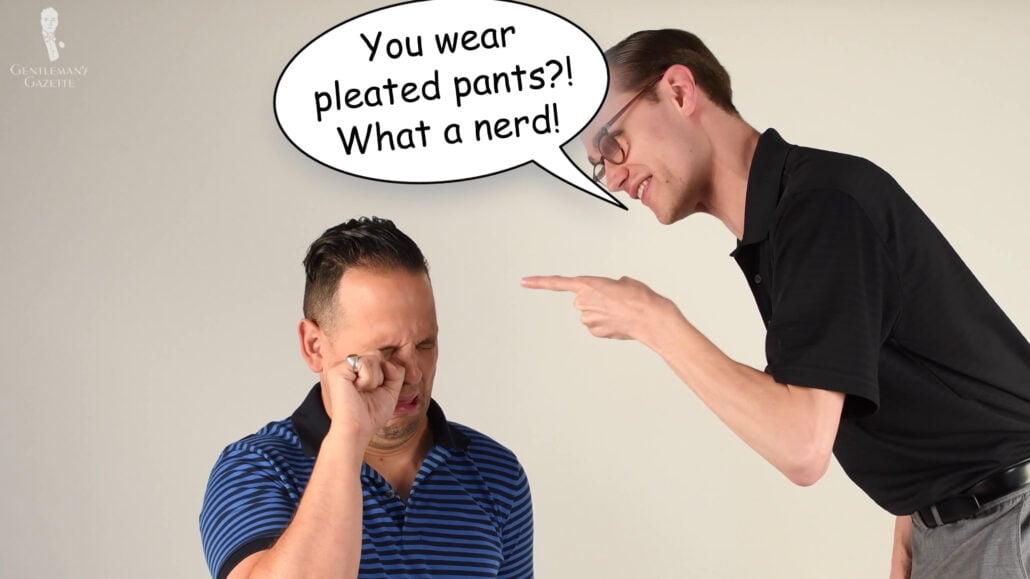
It’s an unfortunate fact of life that fun is often had at the expense of those who don’t conform to society’s ideas of what is popular or, indeed, what is masculine. And as clothing casualized in the 1980s and 1990s, fun was had at the expense of the nerd. Around this time, it became very uncool if you weren’t in on the latest clothing trends.
This was in direct contrast to previous decades, which had a uniform of sorts that consisted of a shirt, jacket, trousers, waistcoat, and so on. But, as denim, sneakers, and bold T-shirts were making waves in the world of fashion in the 80s and 90s, it became increasingly obvious if you weren’t in on these trends. So, those who were sticking to the older, more conservative styles came to embody the “nerd” archetype.
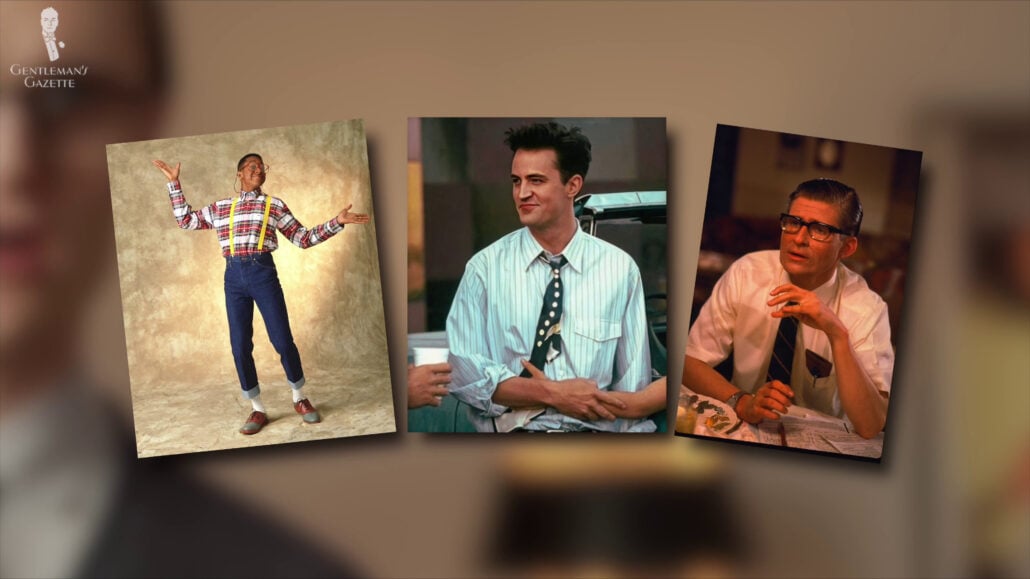
As examples, you can think of characters like Steve Urkel, George McFly, or perhaps even Chandler Bing. In all these cases, you can see how the clothing of the characters has been chosen to emphasize the fact that they aren’t cool. Essentially, it’s a sad fact that pleated trousers came to be a mainstay of this type of character, often in an unflattering fit or a loud or tacky color or pattern to reinforce their status as a social outcast. And really, who wants to be thought of as an outcast?
One of the reasons these characters are dressed in pleated pants might have something to do with the stereotypical nerd’s propensity for being more interested in their work than their style, which we discuss as our next main point.
5. Pleats are Associated with the Workplace
These days, pleated trousers are more commonly associated with the workplace. This reason is pretty cut and dried, but in a world where “casual clothing” means it’s time to relax, who wants to wear work clothing all of the time? After all, a common trope found in many forms of media is coming home at the end of the day to kick off your shoes, loosen your tie, and relax after a long day of taxing work.
What’s illustrated here is that clothing becomes linked to where you wear it and why. So, things like the necktie, dress shirt, and suit have become signifiers that business is to be done and it’s not time to relax.
And, as business casual started to become more common in the American workplace in the 80s and 90s, the famous Dockers khakis were developed as a sort of middle ground – not as formal as a full suit, but not as casual as a pair of jeans. We bet, though, that the original Dockers were definitely made in a pleated style.
So, with many men wearing this style of pants to go to work, even if it was on Casual Friday, it’s easy to see why they would develop an association with being workwear and not be worn during casual time.
6. Modern-Day Clothing Trends
Our sixth and final reason for today why pleated pants have been on the wane is modern-day clothing trends. When it comes to modern fashions, it’s undeniable that, since the mid-2000s or so, there has been a pointed emphasis on skinny or slim-fitting clothing.
The fact of the matter is that pleats simply don’t look very good with modern, low-cut, ultra-tight trousers as the pleat is often far too short and, because the trousers are tight it, will undoubtedly open up leading to unsightly bulging around the waist.
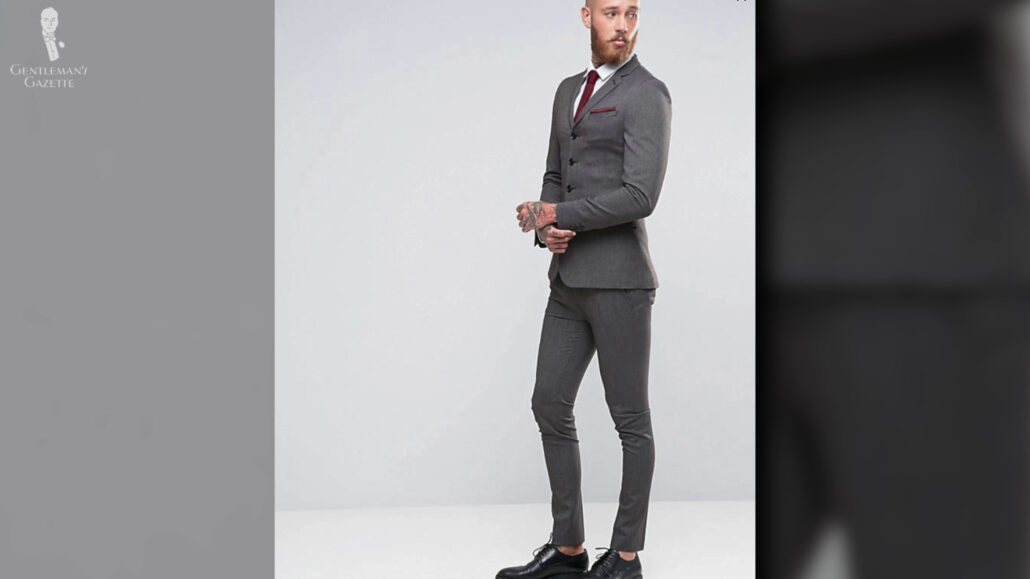
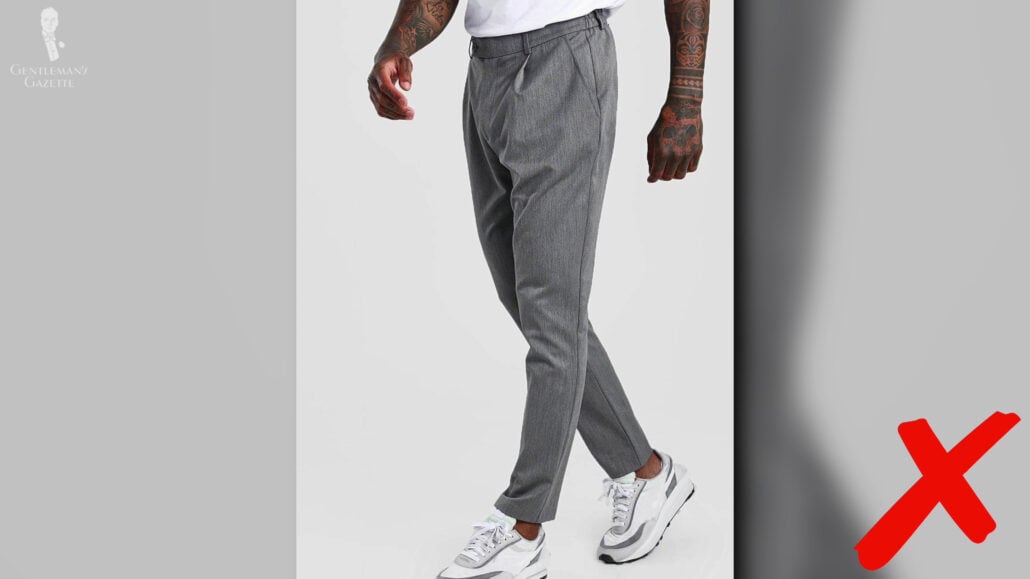
Therefore, it’s easier, cheaper, and more attractive overall to simply offer flat-fronted styles in modern slim-fit trousers.
Conclusion
With all six of these points in mind, then, where does that leave us? Are pleated pants gone forever? Well, although it may be the case for the general population, at least at this point in time, it probably won’t surprise you to learn that we don’t think pleated pants are truly gone for good.
For one thing, directly following up on our sixth and final point, men whose body type doesn’t conform well to skinny or slim-fit styles, such as Raphael for example, love wearing pleated pants for the extra room and range of movement they provide.
And we are gradually starting to see more small and independent clothing makers incorporating pleats that are done well into their lines again. After all, for those in the know about the benefits of pleats, there simply isn’t quite anything like the look that a well-made pair of pleated trousers will provide.
So, while they might not become the dominant fashion ever again, we certainly wouldn’t want to rule it out and we think you’d be hard-pressed to find a more stylish alternative. And, of course, as we’ve hopefully made the case for here. It is certainly possible to wear pleated pants well and, if you’d like to learn more, we made a guide on whether or not we think you should wear them.
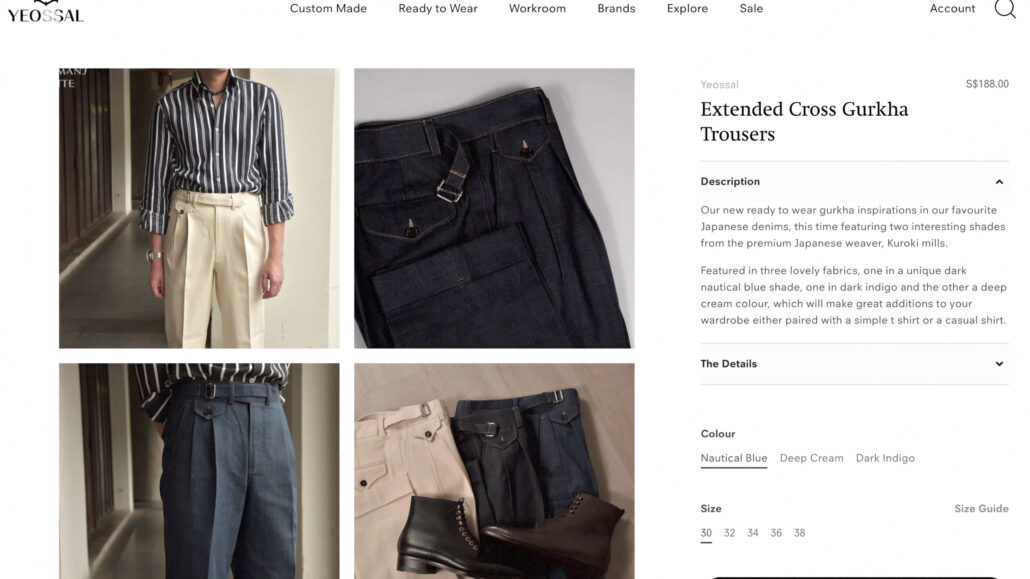
Should You Wear Pleated Pants?
Outfit Rundown
Today, I’m wearing a pair of pleated pants. While I could have gone with a full suit that incorporated pleats in the trousers, I decided to go for a more casual overall look. Therefore, my trousers today are khakis made from a more modern, lightweight fabric.
For this reason and also because the pleats are outward-facing, they don’t sit terribly attractively. Indeed, this isn’t my favorite pair of trousers in my collection, but one that fits the bill of having pleats so I chose to wear them today. Still, I would like to incorporate more trousers with inward-facing pleats and heavier-weight fabrics into my collection in the future.
To go along with these khakis then, I’ve chosen the rest of my outfit in a simple blue and brown color feel.
First up here would be my cardigan, which features tones of both blue and brownish gray. I’m wearing it over a shirt with a micro-grid pattern of light blue and black on a white ground.
Meanwhile, also fitting the color feel and the casual tone my shoes are a pair of tobacco brown suede loafers from Scarosso.
My simple tan belt also harmonizes with my shoes, but it’s not really meant to be seen under the sweater.
The remaining elements of my outfit today are from Fort Belvedere and these are our two-tone shadow-striped socks in brown and light blue and our brown knit tie with light blue stripes.
Of course, you can find both the socks and the tie that I’m wearing today, in addition to a wide array of other classic men’s accessories, in the Fort Belvedere shop.
Do you wear pleated pants, or have you done so in the past? Do you think they’ll die out? Share your thoughts in the comments section!


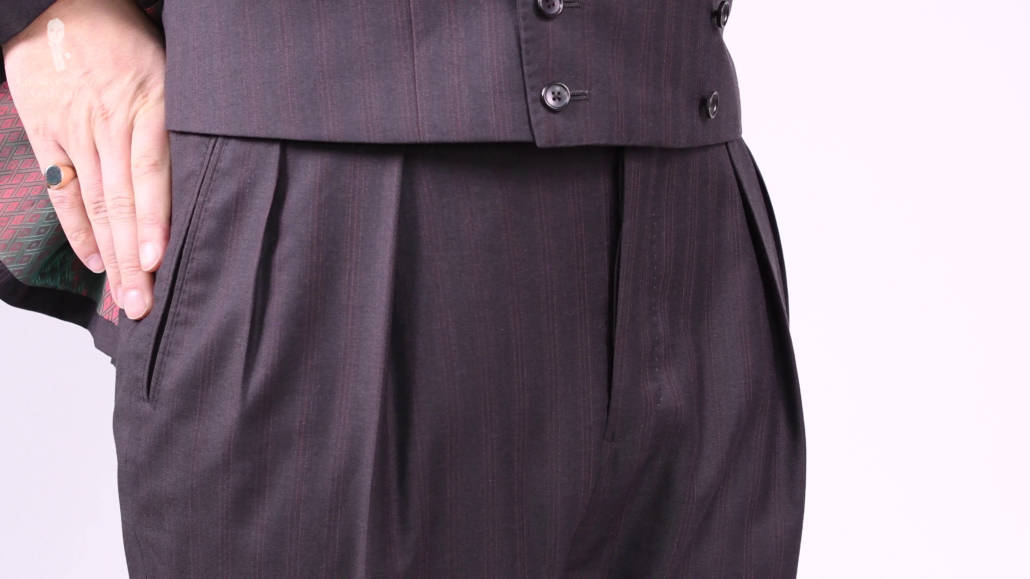
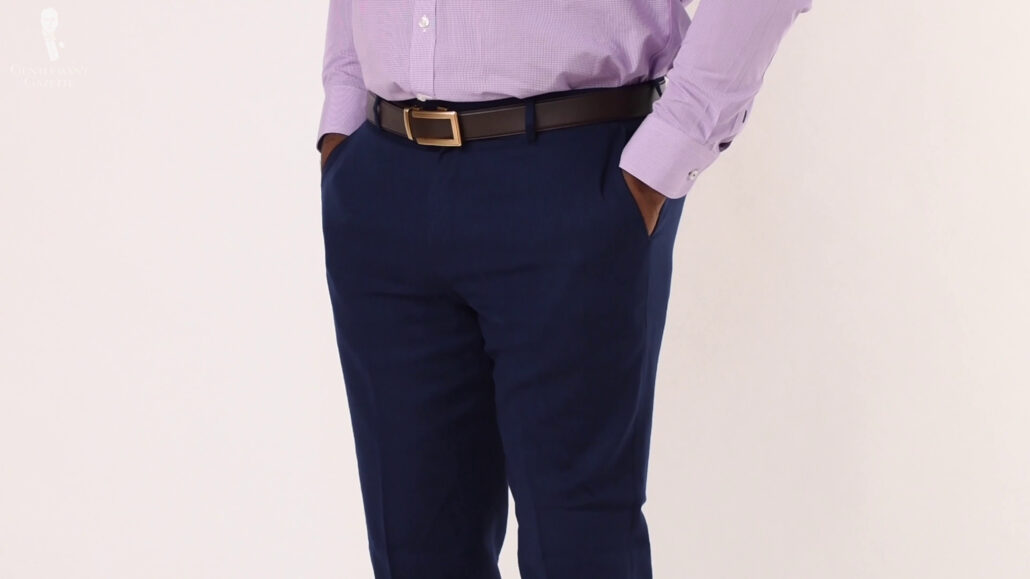
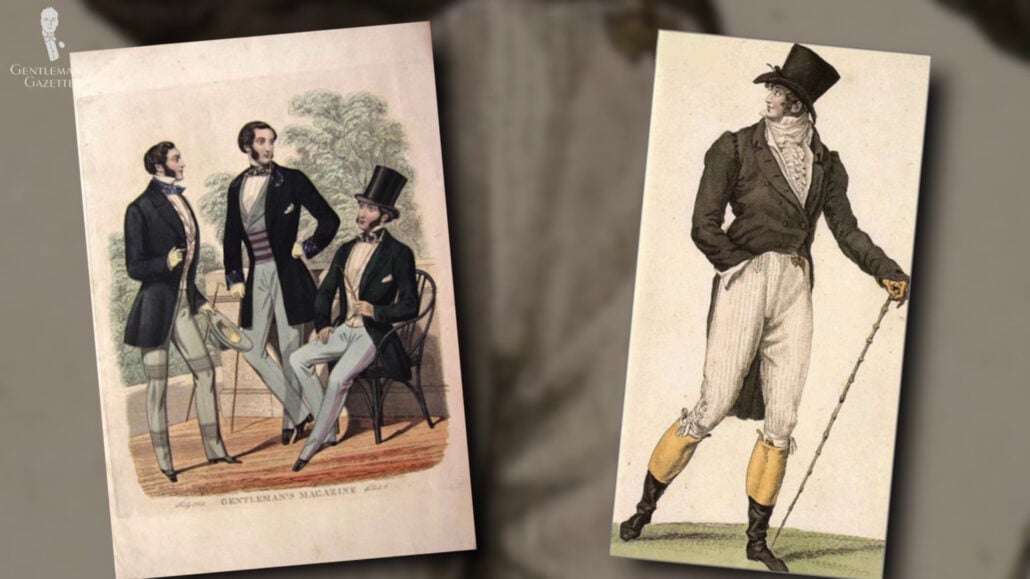
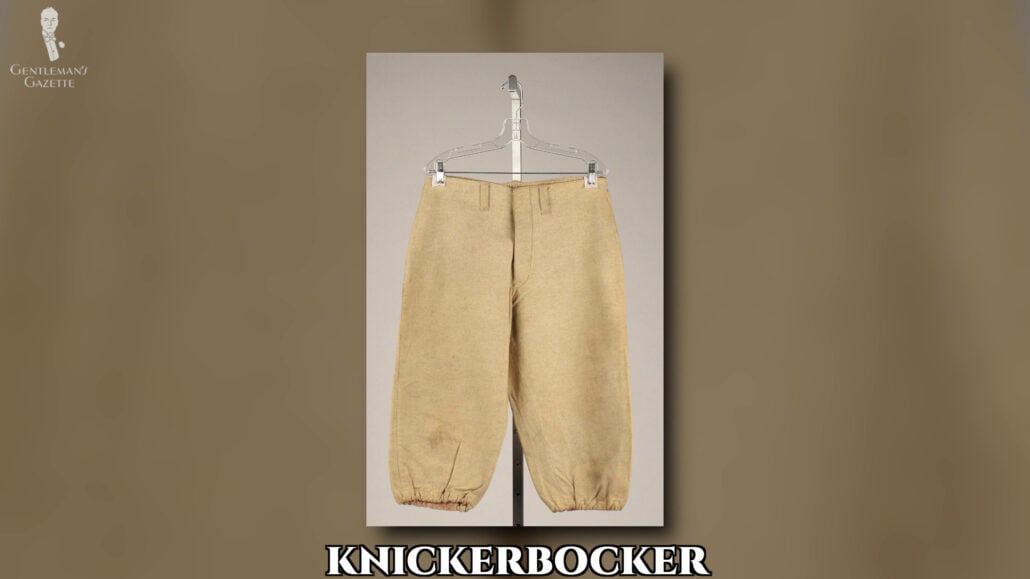
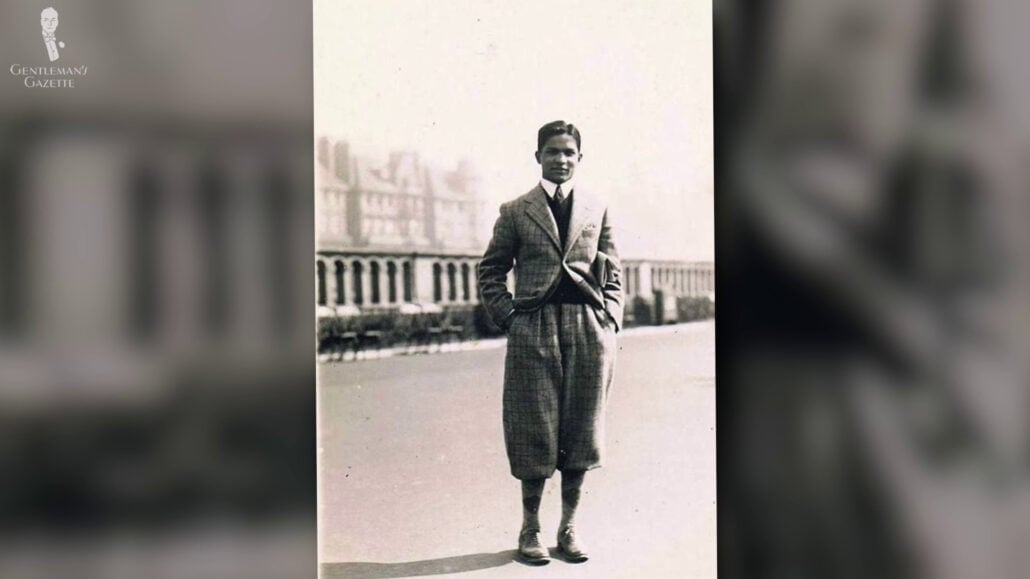
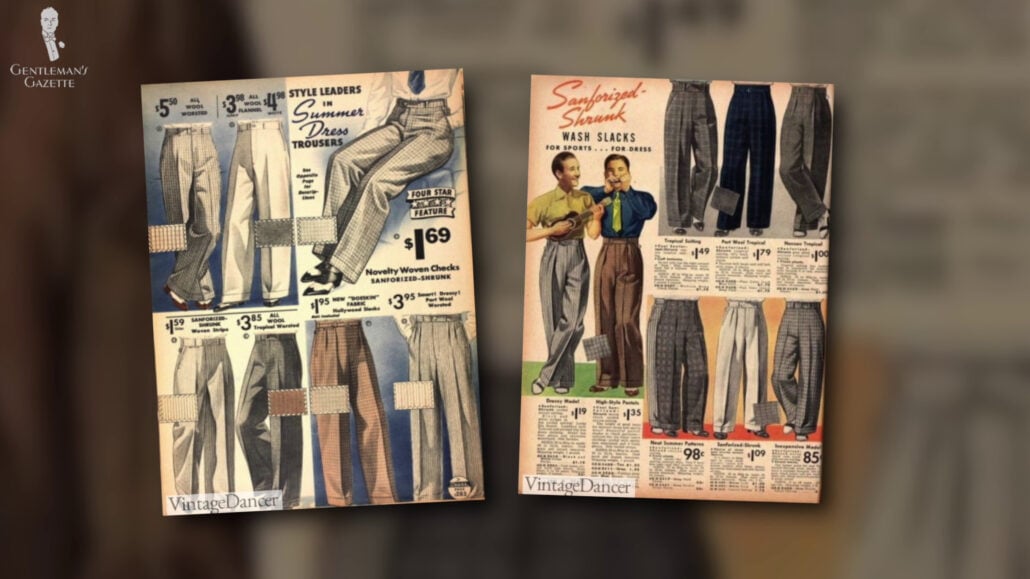
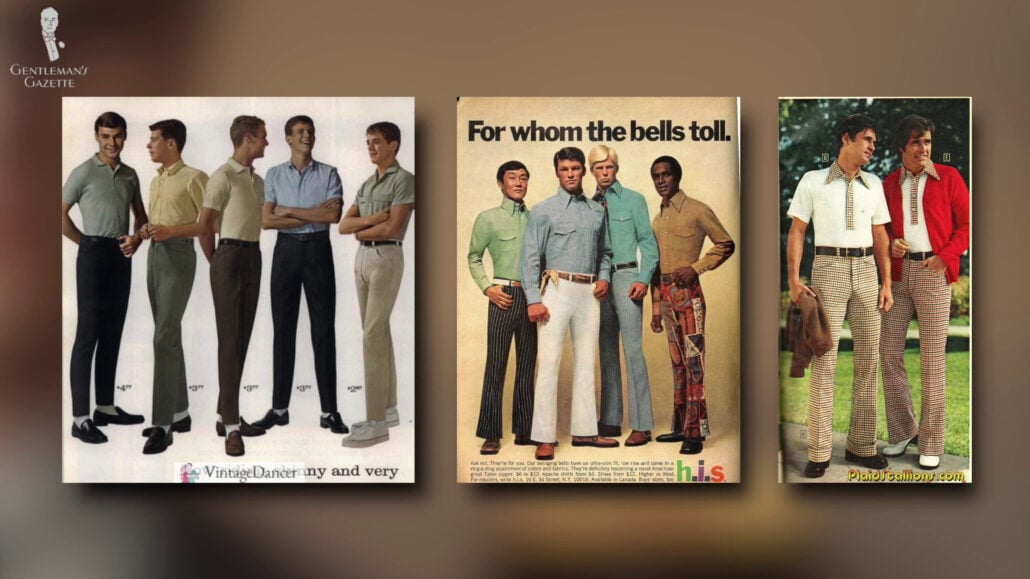
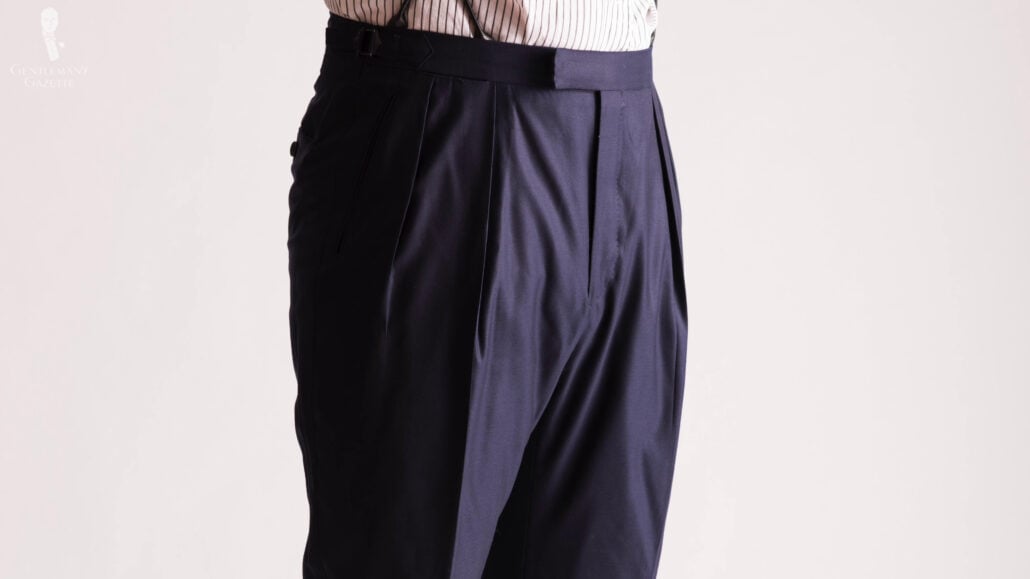
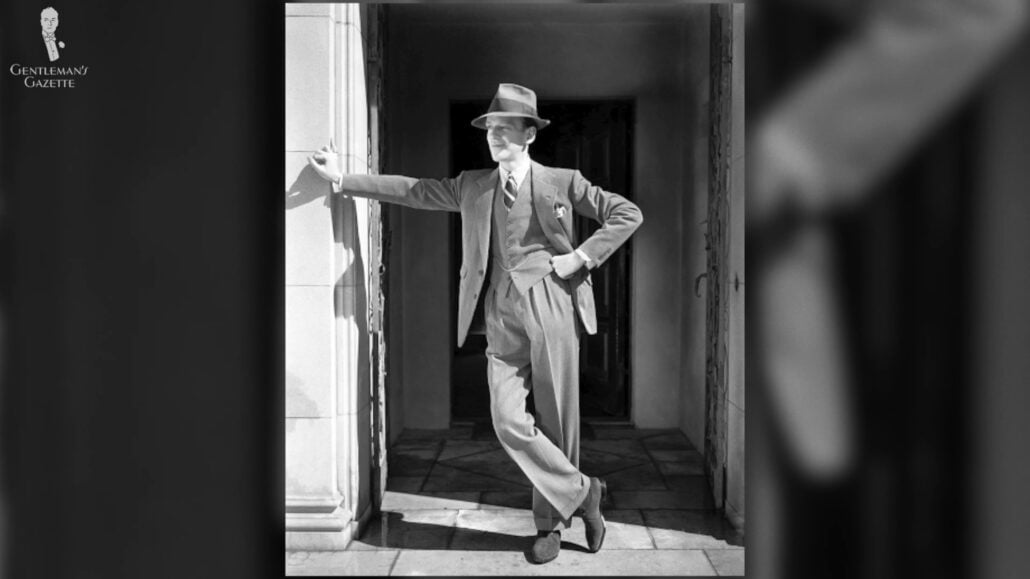
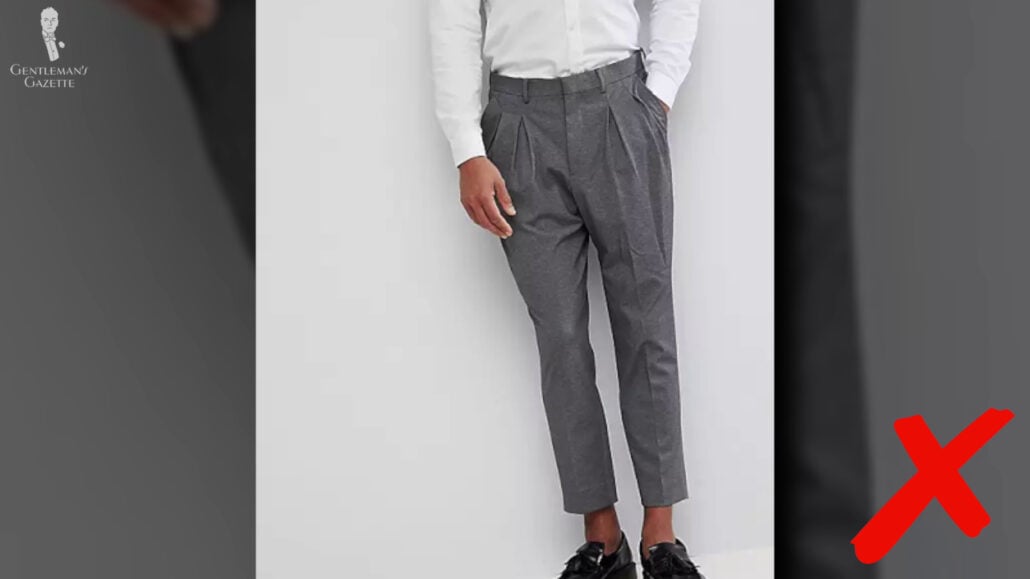
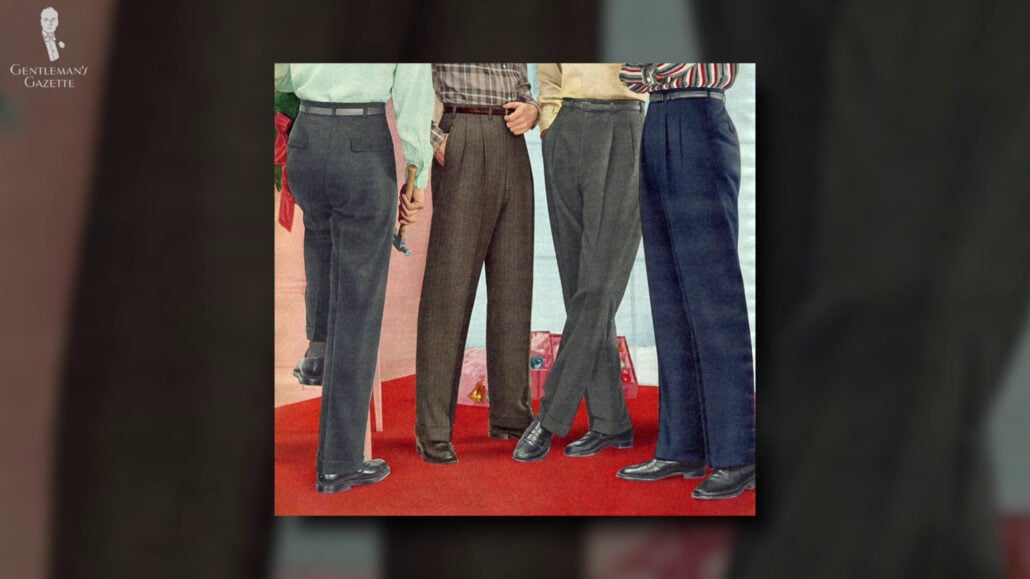
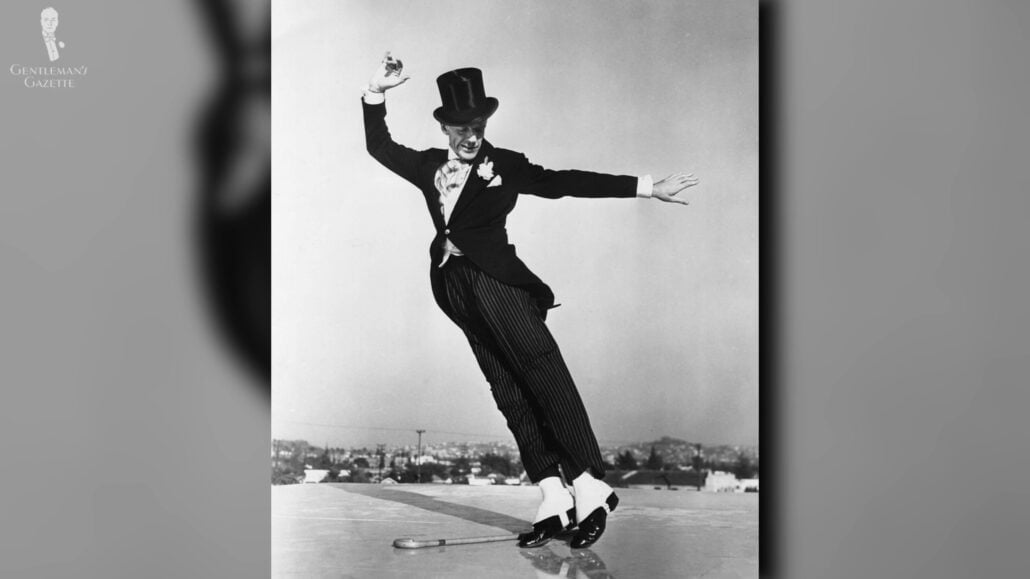
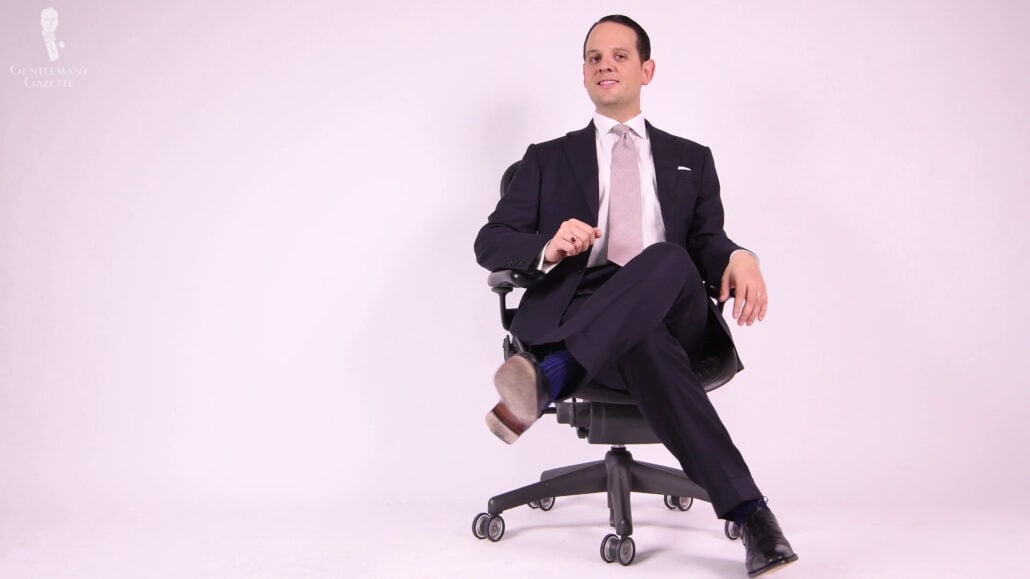
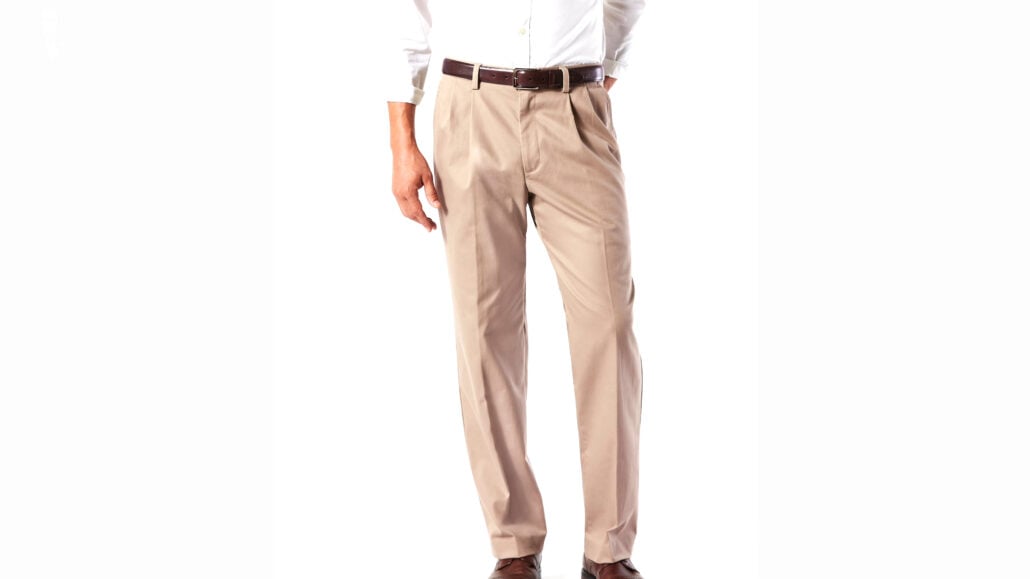
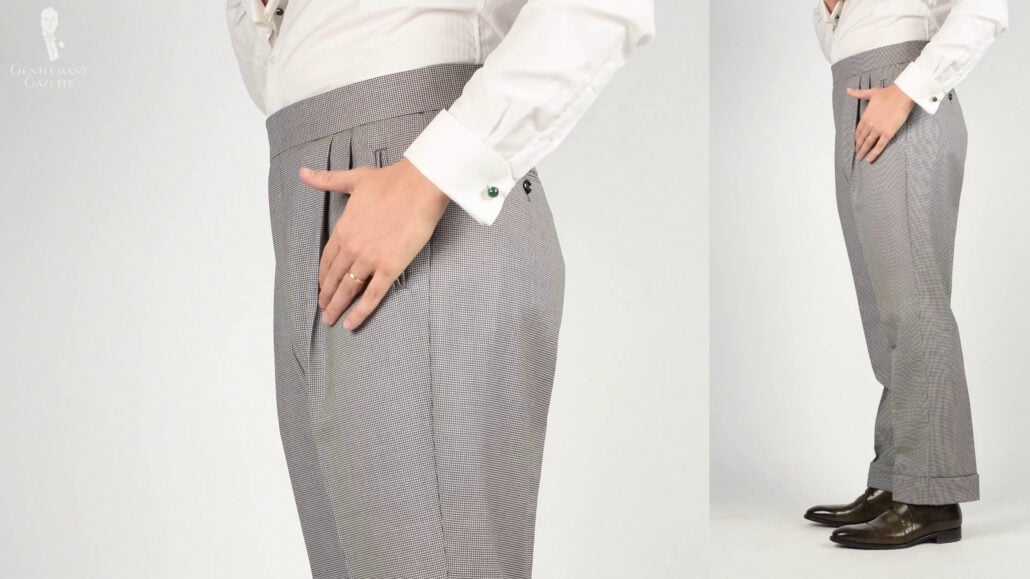
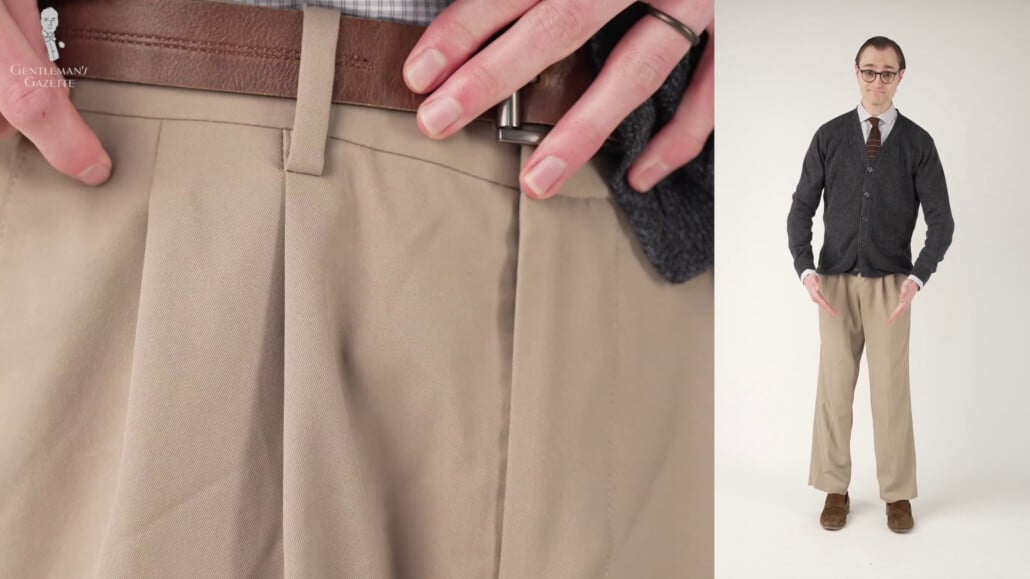
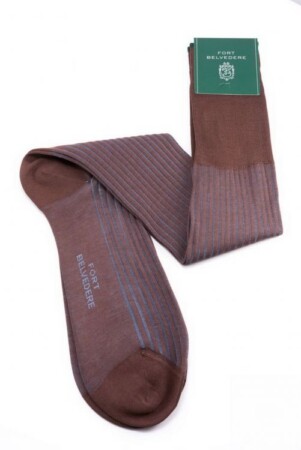
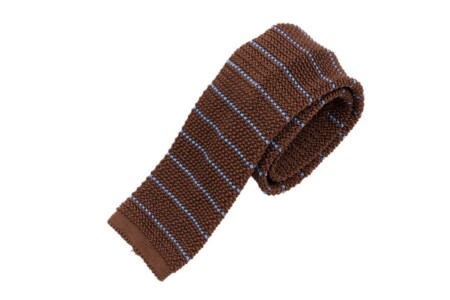
I’m a bit older than you gentlemen and I recall that flat-front tighter trousers came into fashion in the early ’60s with the “British invasion” pop music trend. Mod style. An Italian aesthetic of close-fitting suits, motor scooters, and sunglasses were all the rage. The late ’60s brought bell-bottoms and flares and there were occasional pleated trousers on followers of the nostalgia craze that took place in the early ’70s. (see David Bowie) Pleats didn’t become widely accepted again though until the later 1980s with the emergence of an embracement of a 1930s /40s look in the later ’80s as you pointed out in your recent article on the “Wall Street look”. At the same time, Hip Hop music gained in popularity and those artists went for baggy and loose-fitting clothes. There is often a correlation between popular music and fashion. Being a musician, this was always important to me, and the images I had to carry in the various trends and styles which came and went were essential to my work.
William,
Great points! Mop top haircuts and Beatle boots were out of the question for most middle/lower middle class teens at the time. But.., flat front pants were something moms could see themselves saying Yes to. Bowie was always something of an enigma. How anyone can be counter culture and mainstream at the same time baffles many even in his absence? Played British Blues-based guitar most of my life! You?
On a side note, living in Manhattan’s Lower East Side, I see a lot of young men wearing very slim suits with stretchy fabric and high inseam, and the majority do not look good in them. They’ve got the wrong body type – a bit fleshy, with heavy or wide thighs.
The skin-tight fabric accentuates this, resulting in a somewhat comical and very un-masculine effect! In fact, quite a lot of men have wide thighs. I think the ubiquitous advertisements with skinny, athletic guys in these suits makes them believe that they’ll seem skinnier in a skinnier suit fashion.
Clearly the heavier-draped fabrics of the past were better at presenting an attractive silhouette.
Amen.
And therein lies another issue. Touching on the comment of modern clothing trends, I’m seeing a growing trend where people in general are opting for clothing simply because it’s available, cheap and/or trendy. The new battle cry seems to be ‘dress how you’re comfortable’ and ‘as long as you’re comfortable, nothing else matters – it’s what’s inside.’ I’m not in any way trying to suggest body shaming or that one’s clothes define the individual (whether men, women or otherwise.) Rather, it’s my opinion that these battle cries or slogans, while well meaning, lead to people putting less thought into their outfits and what cuts of garments/clothing styles even fabrics actually suits their body type. Eg. The above example of athletic built men and/or men with wide thighs (ones who are more solid like say, Sven Raphael Schneider) in slim/skinny fit suits giving them an un-masculine appearance. On a man with a build like Preston Schlueter, a slim fit suit or slim fit trousers are fine even flattering; on someone with a heavier build, though, it can blow other things out of proportion and emphasise all the unflattering body parts. Eg. Shoes look larger and almost clown like.
I don’t own a suit or a pair of dress or casual, (not jeans) trousers that don’t have pleats. They’re what make dress pants, dressy.
Exactly!
I suppose I am one of the remaining few who still embrace pleated trousers. In fact, I do not have one pair of dress or casual trousers in my entire wardrobe that does not have pleats and cuffs. It’s true, they seem to drape better than do flat front trousers and I just prefer that roomier fit.
My imagination or are the pants in the Sven and Preston photos a tad short from the shoes? Maybe a bit longer with a bit of a break? Especially pleated pants.
William, you are spot on.
Unfortunately it seems to be another growing trend: shorter or cropped leg trousers. I’m looking for some suit separates to update my work wardrobe and just browsing online, I was appalled at some of the models with bare foot visible when they’re shown with the sockless look. https://www.myer.com.au/buy/mens-pleated-trousers
Just yesterday I was bemoaning skinny legged pants with a friend. Very young, thin guys can kind of get away with them, but even then, I don’t think they’re flattering. But they are fashionable, and fashions, once they become dated, are suddenly viewed objectively. Think flare bottom pants in the sixties and seventies. It was almost impossible to avoid them. Skinny legged pants will meet their judgment day, as well. I have some pleated khakis, which I love. The really worn ones are nice for lounging around the yard on hot summer days, when anything clinging would be miserably uncomfortable.
That’s because they’re not flattering. For starters, they emphasise the wearer being skinny and put other things out of proportion. The most obvious one that comes to mind is the wearer’s shoes – they look much larger in contrast to the point of looking clownish or cartoon clownish. Here’s an article from Centeno at RMRS which explains flaws of skinny leg pants (jeans, anyway) in more detail: https://www.realmenrealstyle.com/men-wear-skinny-jeans/
If we’re talking about slim fit pants, though, especially on someone slim with a build like Preston’s then I can’t see the issue. Contrary to common misconceptions there is a difference between skinny and slim fit trousers.
Hi! I am down to my last two pair of pleated trousers here in closet. The first pair hang with my mix and match tux “options”. I wore my pleated trousers with a notched lapel jacket (sorry Sven it seemed like a good idea at the time and the pix were great) to my only daughter’s wedding in Memphis this past November. The other pair is a ridiculously roomy pair of Bill’s Khakis which make me give tribute to the late great General Douglas (rip) MacArthur.
Loved the article! Did you happen to dip into David Bowie’s interest in (obsession with) pleated bottoms during your research?
Thank you, Preston, for the nice history and analysis. Having lived through the last 40 years as a custom tailor and patternmaker, it appeared to me that when menswear again became “slim fitting” the patternmakers didn’t know how to properly cut trim clothing — including unconstructed jackets — and instead just made things tight. Basically, one cannot simply do the latter and have anything fit properly.
About the same time I began rewatching some of my favorite TV shows from the 60s, The Saint and Secret Agent Man, starring Roger Moore and Patrick McGoohan, respectively. Both were always impeccably tailored, whether formally or informally dressed, and quite often wore exquisite trim pleated pants, usually in a lightweight tropical wool suiting (sorry, Preston… I also had a wonderful pair of cotton/rayon pleated Girbaud pants in the day which were very lightweight). Anyway, this puts the lie to the idea that pleated pants can’t also look trim, though it does help to have a crisp fabric. Having simultaneously gone back to cutting slim pants, for customers and for myself, I quickly discovered various things that need to change in the patterning in order to have correct and pleasing proportions. Also, having “soccer” legs myself, fit through the thighs has always been an issue for me and my sons. Unfortunately, none of these patterning alterations occur in any tailoring books I own, many going back decades. And construction needs to support all of this to make it work.
Thanks again.
Hi Philip, thanks for your input – especially from your point of view as a tailor and patternmaker. The cut and make are definitely things that we wanted to draw attention to in the article and video, and it’s really interesting to hear that there seems to be little in the way of recorded knowledge for making any required alterations.
Secret agent… There’s a man who puts his shirts
on hangers!
OK, I am 78 years young, fairly fit but with an endomorphic body style. I use to wear pleated pants a majority of the time but my wife feels they make me look puffy. I am currently undergoing a change in my style. Being from Boston I was brought up Brooks Brothers, but I changed course when I joined the naval service. MY attempt at a novel is coming to fruition in the late spring and I feel a more “mature” look on a book tour or lecture is called. By muse calls me an ego trip and told me to save my money and just go simple casual. I am in a quandary, What would you suggest. I am five feet eight and currently 200 pounds. I have a stomach overhang from a wound. Is this too much info or are you “guys” OK with it.
Hi Ken, thanks for reaching out, and congratulations on the novel!
I’d suggest our business casual guide is a great place to start, as it holds some of the best tips for dressing well without overdoing it.
Have a great book tour!
Congrats of course, but unless you’re Charles Bukowski, pleats! Lol. Most of my closet is BB.
My bespoke suits’ trousers have pleats as well as my dress trousers. My 8 wale Brisbane corduroys, Moleskin and chinos are all plain front. I would never think of having them with pleats; they wouldn’t look right. They would look extremely tacky.
I wear braces with my pleated trousers. The braces hold the pants up naturally instead of bunching them up with a belt.
The author of this article should have had his pleated chinos ironed beforehand. They looked like he slept in them.
The author of this article should have the pants altered and hemmed before putting them on. They look far too baggy and like they’re puddling at the bottom of his shoes. On a slim man like Preston, pleated pants can have a way of emphasising a very slim build just as slim fit on a more solid man (think someone with more of an endomorph build like Sven Raphael Schneider) emphasises wider legs or larger mid-section.
I have to agree. Preston does not seem to enjoy well pressed trousers, which has the unfortunate effect of making them look cheaper than they probably are. A sharp crease will elevate the look of even the cheapest trousers. I never leave home without a razor sharp crease in my suit pants or slacks, including pleats when wearing them. It just finishes the look. But then again I also like heavily starched shirts also.
Half the time he also doesn’t seem to enjoy the right fit or length. His pants are often either too short or puddling at the hems, which also cheapen the look. I agree wholeheartedly about sharp creases (and pressing trousers and shirts in general) really enhancing one’s overall appearance.
Also possible, as with a great many things, especially post-80’s, pleats became a much more feminine thing. Don’t get me wrong they look great on the gals but like padded shoulders in the 80’s a trend more often dominated by women’s designers.
All of which of course is a shame, I’ve got a closet full of excellent pleated trousers, but seldom are there occasions refined enough to wear them these days.
An interesting point, Matt. I suppose both men and women have been utilizing pleats in their clothing for hundreds of years at this point, but the 80s did see pleats as a big feature on women’s pants too.
You say pleated trousers are increasingly difficult to find? May I divert your attention to “across the pond” to steal your phrase? In Europe pleats have become the new norm yet again with flat fronts dying an agonizing death. The America’s are usually about 5 years behind Europe, so hold tight and watch this space.
This article came at the right time. Hopefully, the fashion designers and manufacturers will
force more consumers to present themselves with a better appeal.
My selection of pants, which includes casual or dress has always been pleated first, for over a half-century.
Casualization at times is understandable but at least present a neat appeal with it.
With the loss of custom Taylors, and non-excisting Boutiques we are at the mercy of limited chain retail shopping.
I have a comment that I believe men would appreciate that is overlooked in your article. pleats work well for someone like me. It gives me breathing room for my boys below the waist (BBTW). The fashion drivers that have taken this away forgot that they owned a pair, and if they dod not they overlooked those that do! I am not bragging or making this a big deal (no pun intended) but the fact is when you have a high quality material pleated, it remains in the field of classic wear, not outdated fashion
I have never been accused of being trendy so I have worn pleated trousers since I started school in 1969. I just think they are a great look. I also have plain fronted trousers that also fit nicely, so I can’t really say I prefer one over the other. I enjoy them both and basically always have.
Sorry but, probably one of your worst treatise… Pleats are still worn, and I for one will still wear them on suits, with cuff too… Sadly correct wear has become a myth, however as you grow older the fashions of teen agers is NOT what you should think of as properly dressed. I grew up in the Seventis as a teenager and the biggest influence on me and my friends was Bryan Ferry..#0’s Styling proper dress and making the effort…All things that count not today.
Dont forget Mr. Robert Palmer!
I agree, pleats haven’t completely vanished from Earth along with hats, dress shoes or vests/waistcoats and whatever else GG is claiming men have stopped wearing. They are becoming a lot less frequently seen on trousers, though, especially on those born after about 1975; the exceptions being on uniform trousers, especially in the military and perhaps the police forces. Even then in Australia, though, pleated pants on police uniforms are seemingly fast being replaced by loose fitting cargo pants not unlike what one typically sees on construction site workers. The ones born after about 1975 who wear pleated pants tend to be classic menswear enthusiasts like Raphael who dress more formally as a hobby.
I tend to agree with most of the reasons offered as to why pleats are (if you prefer) becoming less frequently seen; apart from mass clothing manufacturing with cheap poor quality and poor fitting clothes, I think along the same lines as you about correct wear (or dressing appropriately as opposed to ultra or sloppy casual nearly 24/7) being the main reason.
I have several pairs of pleated trousers. As you’ve pointed out they are best suited to heavier fabrics so as to hang and better keep their shape. They seem to look well on me now I’m a bit heavier.
I dont think they should be worn with a belt. Braces, as they are called this side of the pond, seem to work best. Otherwise they balloon around the front section and don’t look at all fitted. I get mine from Cordings in Piccadilly, by mail order actually. I buy them with a zip fly now rather than buttons, which I find way too fiddly. They aren’t cheap, but quality never is, and the price is always soon forgotten.
I respectfully disagree, pleats are making a come back! Suit retailers (like SuitSupply or Ralph Lauren) or more casual wear (like J. Crew) are now offering pants with pleats, something I had never seen until ~3 years ago.